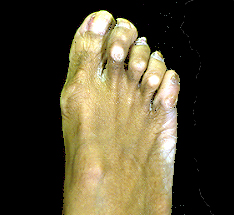
|  |

 |
|
|

|
What are they?
Corns are the hard,
thickened areas of skin, which frequently are located
 on the
top, ends, and outer portions of toes. Corns are our body’s response to
chronic friction and pressure. The response is to build up skin to protect
the area of friction. Often times, an underlying section of bone beneath the
corn is the culprit. As the skin builds up so does the pressure and pain to
the area. III fitted shoes, abnormal toe structure, and arthritic conditions
are common causes of these annoying lesions. on the
top, ends, and outer portions of toes. Corns are our body’s response to
chronic friction and pressure. The response is to build up skin to protect
the area of friction. Often times, an underlying section of bone beneath the
corn is the culprit. As the skin builds up so does the pressure and pain to
the area. III fitted shoes, abnormal toe structure, and arthritic conditions
are common causes of these annoying lesions.
How do you treat them?
It seems obvious that with most
any existing ailment of the body, one of three things can happen. The
condition can improve and go away, it can stay the same or it can become
worse. Corns are an orthopedic condition and either one has to accommodate
the deformity to try to make it go away or correct the deformity. First of
all, it is essential to check and modify if necessary, one's shoes so as to
minimize excessive pressure at the area involved. Quite often, wearing a
better-fitted shoe is enough to remedy the problem. Secondly, one should
stay away from store bought medicinal pads and sharp cutting instruments as
possible remedies. Self-abuse through the improper use of these items can
often result in more serious damage to the skin. A third and most important
suggestion for the person with a painful corn is that he seeks professional
care.
Appropriate care for this
problem is often necessary in order to correct or at least, prevent further
progressive changes. Treating one's own foot problem is not necessarily
detrimental when performed carefully and under the right conditions. The
diabetic, the older aged individual, or the person with obvious circulatory
problems are certainly in need of professional care and should not attempt
self-treatment procedures. There are some surgical approaches to the
treatment of corns to attempt to permanently correct the condition. Everyone
can live with a non painful corn, but when the pain interrupts one's daily
walking, it often requires professional management.
|